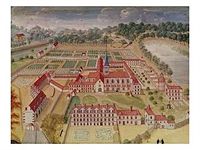Louise-Magdeleine Horthemels

Louise-Magdeleine Horthemels, or Louise-Madeleine Hortemels, also called Magdeleine Horthemels (1686 – 2 October 1767), was a French
Life
The
Active as a
Louise-Magdeleine Horthemels' son Charles-Nicolas Cochin the Younger became an engraver to the court of
Horthemels died in Paris at her son's house on 2 October 1767.
Work

Horthemels was active in Paris as an engraver for nearly fifty years and produced more than sixty signed copper plates.[1]
Her first published work was a frontispiece for Alain-René Lesage's novel Le Diable boiteux (1707), which she signed Magdeleine Horthemels fec.[1] Her later work is signed variously Magd. Horthemels, L. Mag. Horthemels, M. Horthemels, Magd. Horthemels Sponsa C. Cochin, and Magdeleine Cochin.[1]
It was long believed that Louise-Magdeleine and her sisters Marie-Nicole and Marie-Anne-Hyacinthe all signed work Marie Horthemels, but a careful study has shown that the signed work of the sisters can easily be distinguished. Nevertheless, the members of the family commonly worked together on a single composition.[1]
Louise-Magdeleine Horthemels engraved paintings by
Horthemels completed a great plate called Le feu d'artifice de la place de Navone, after
In the early work of Horthemels as an engraver, there is a certain rigidity of line, while architectural detail is emphasized. However, her skill lay in engraving the work of others so that their genius was revealed and her own style was suppressed. Her hand was sure, and her work shows a delicacy and clarity of touch which were much admired in her own time.[1]
Gallery
- Abbey of Port-Royal des Champs, by Louise-Magdeleine Horthemels, c. 1709
-
Caring for the Sick
-
Distributing Alms to the Poor
-
The Sisters of the Abbey
-
General View
-
Nuns Meeting in Solitude
-
View of the Refectory
References
- ^ a b c d e f g h i j k l m Louise-Magdeleine Horthemels: Reproductive Engraver by Elizabeth Poulson in Woman's Art Journal, vol. 6, no. 2 (Autumn, 1985 – Winter, 1986), pp. 20–23
- ^ Les Forces Mouvantes at georgeglazer.com (accessed 11 February 2008)
- ^ Alexis Simon Belle biography at getty.edu (accessed 14 February 2008)
- ^ Charles-Nicolas Cochin, b. 1715 Paris, d. 1790 Paris, draftsman Archived 4 July 2007 at the Wayback Machine, short biography at getty.edu (accessed 14 February 2008)
- ^ Woman having her hair styled, eighteenth century engraved by Louise-Madeleine Horthemels after Nicolas Lancret, line engraving, at the web site of the New York Public Library digital collection (accessed 14 February 2008)
- ^ Augustin Gazier, Histoire générale du mouvement janséniste (Paris, H. Champion, 1924) volume 1, pp. 228–230
- ^ NPG D10695 Prince James Francis Edward Stuart after Alexis Simon Belle, line engraving, early 18th century, at the web site of the National Portrait Gallery, London (accessed 14 February 2008)
External links
- Louise Madeleine Cochin (née Horthemels) (1686–1767) at the web site of the National Portrait Gallery, London






